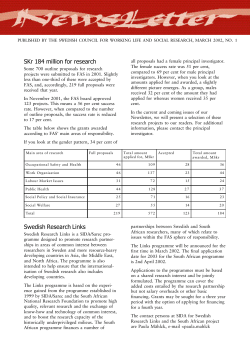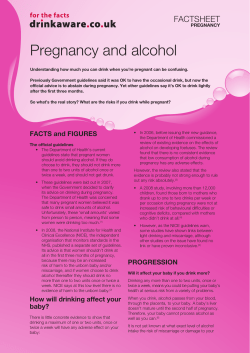
Preventing FAS/FASD in Russian Children Prevent FAS in Russia Research Group Tatiana Balachova
Preventing FAS/FASD in Russian Children Prevent FAS in Russia Research Group Tatiana Balachova Elena Varavikova 1st Central and Eastern European Summit on Preconception Health and Prevention of Birth Defects August 27-30, 2008 1 University of Oklahoma Health Sciences Center in collaboration with St. Petersburg State University Phase I: Preventing FAS/ARND in Russian Children, NIH/Fogarty International Center, 2003-2007 Phase II: Development of Education Materials for Prevention of FAS in Russia, Centers for Disease Control and Prevention (CDC)/Association of University Centers on Disabilities (AUCD), 2005-2008 Phase III: Health of Children in Russia: Providing Education on FASD, AUCD/CDC, 2007-2008 Preventing FAS/ARND in Russian Children, NIH/NIAAA, 2007-2012 Materials developed by the Centers for Diseases Control and Prevention, National Institute on Alcohol and Alcohol Abuse, U.S. Substance Abuse and Mental Health Services Administration, the Regional FASD Resources and Training Centers, other organizations, and the project faculty and consultants have been used for this presentation. 2 Project Team St. Petersburg State University, Russia Larissa Tsvetkova, PhD University of Oklahoma Health Sciences Center Galina Isurina, PhD Barbara Bonner, PhD Alexander Palchick, MD, PhD, Academy of Pediatrics Tatiana Balachova, PhD Vladimir Shapkaitz, MD, PhD, Academy of Pediatrics Mark Chaffin, Chaffin, PhD Elena Volkova, PhD, Nizhny Novgorod Pedagogical Consultants Academy Lubov Smykalo, Max Gusev, Maria Pechenezskaya, SPSU Karen Beckman, MD, OUHSC Edward Riley, PhD, San Diego State University Data Collectors in St. Petersburg and Nizhniy Novgorod Linda Sobell, PhD, Nova Southeastern University Jacquelyn Bertrand, PhD, CDC Oleg Erishev, MD, PhD, Bekterev Institute, St. Petersburg Corinne Reinicke, MD, WHO, Moscow (2007) Michael Fleming, MD, MPH, University of Wisconsin Mark Mengel, MD, MPH, University of Arkansas Danny Wedding, PhD, MPH, University of MissouriColumbia Advisory Board Sheldon Levy, MPH, PhD, University of Miami School of Medicine John Mulvihill, MD, OUHSC Edward Riley, PhD, San Diego State University Kevin Rudeen, PhD, OUHSC 3 Mark Wolraich, MD, OUHSC Elena Varavikova, MD, PhD, MPH, Federal Agency for Medical Technologies, Russia FASD terminology Fetal Alcohol Syndrome (FAS) – One of the diagnoses used to describe birth defects caused by alcohol use while pregnant – A medical diagnosis (760.71) in the International Classification of Diseases (ICD) – The most common preventable cause of mental retardation in the world Fetal Alcohol Spectrum Disorders (FASD) – Not a diagnosis – Umbrella term describing the range of effects that can occur in an individual whose mother drank alcohol during pregnancy – May include physical, mental, behavioral, and/or learning disabilities with possible lifelong implications FAS Alcohol-related neurodevelopmental disorders (ARND) Alcohol-related birth defects (ARBD) 4 Fetal Alcohol Syndrome Specific pattern of facial features Pre- and/or postnatal growth deficiency Evidence of central nervous system dysfunction Short palpebral fissure Indistinct philtrum Thin upper lip5 Child with FAS and mouse fetus with fetal alcohol exposure 6 Diagnostic criteria FAS: facial features Source: Astley, S.J. 2004. Diagnostic Guide for Fetal Alcohol Spectrum Disorders: The 4-Digit Diagnostic Code, Third Edition. Seattle: University of Washington Publication Services. 7 Growth Deficiency 8 Source, Ed Riley, 2004 Brain Regions Affected Normal brain of baby 6 weeks old and brain of baby same age with FAS Photo courtesy of Dr. Clarren The Cerebral Cortex The Hippocampus and Cerebellum The Corpus Callosum 9 Primary CNS dysfunction Decreased I.Q. Specific deficits in reading, spelling and math Fine and gross motor problems Executive functioning deficits Communication and social interactions problems Growing up with FAS Photo courtesy of Dr. Streissguth Attention problems and/or hyperactivity Memory deficits 10 FAS Prevalence Fetal alcohol syndrome – 0.5 to 2/1000 live births in USA (May and Gossage, 2001) – Higher rates in some populations 0.3/1,000 non-American Indian/Alaska Native, Alaska (2002) 5.6/1,000 American Indian/Alaska Native Compare Down syndrome…….………..1/800 births Cleft lip+/-palate……………..1/800 births Spina bifida…………………1/1000 births Incidence of FAS in subsequent births 771 per 1,000 live births (Abel, 1988) 11 FAS Prevalence FAS – active case ascertainment at schools – 3.1/1,000 in Washington State – 3.7 to 7.4/1,000 in Italy (Clarren et al., 2001) (May et al.,2006) Highest documented rate in South Africa – 40.5 to 46.4 per 1000 children aged 5 to 9 (first grade population)/39.2 to 42.9 age-specific community rates population) for ages 6–7 (May et al., 2000) – 65.2-74.2 per 1,000 children –second study in the same community (Viljoen et al., 2005) 12 FASD Prevalence Combined FAS, ARND, ARBD estimated la a t Fe lc ctru e p ls o h o i so d m rd ers 10/1,000 the birth population in USA (May & Gossage, 2001) 23 to 41/1,000 in Italy (May et al., 2006) 13 FASD Facts Alcohol is a teratogen “Of all the substances of abuse including cocaine, heroin, and marijuana, alcohol produces by far the most serious neurobehavioral effects in the fetus.” —Institute of Medicine Report to Congress, 1996 Prenatal alcohol exposure is the leading preventable cause of birth defects, mental retardation, and neurodevelopmental disorders The cause is maternal alcohol use during pregnancy – No safe time to drink during pregnancy – No safe level of alcohol Binge drinking is especially harmful Lower level of prenatal alcohol exposure is adversely related to the child behavior (Sood et al., Pediatrics, 2002) 14 Alcohol consumption in Russia • One of highest levels of alcohol consumption and burden of disease attributed to alcohol in world (WHO, 2005) • Most hazardous patterns of consumption (Bobak et al., 1999) Estimated adult alcohol consumption per person per year (WHO, 2005) 15 Alcohol poisonings and life expectancy at birth in Russia (M+F), 1965-2006 60 72 R= - 0.94 Life expectancy 70 40 68 Gorbachev anti-alcohol 30 66 campaign 20 64 Alcohol poisoning per 100,000 10 62 0 1965 60 1975 1985 1995 2005 Source : VM Shkolnikov 16 Life expectancy, years Death rate per 100,000 50 Increasing alcohol consumption 80% increase in alcohol consumption from 5.38 liters of pure alcohol per person in 1990 to 9.7 liters in 2005 Increasing consumption of other alcohol containing products surrogates, perfume, cosmetics, household chemicals, and “samogon” (moonshine) Real consumption is higher about 15 liters of pure alcohol per person per year Chief Medical Officer of the Russian Federation, 2007 17 Changes in consumption Marketing target women and youth Increasing production of – low alcohol-containing (9% and less) beverages (6 times) and – beer (3 times) between 1998 and 2006 In 2006, sales of alcoholic beverages consisted of beer (75%), vodka and liquors (16%), wine (8%), and cognac (1%) Increasingly hazardous drinking in young people and women Chief Medical Officer of the Russian Federation, 2007 Damskaya (Ladies’) vodka: Producer beliefs that vodka is not more harmful than chocolate 18 Alcohol consumption by women In a convenience sample of 899 women in St. Petersburg in fall 1999 - spring 2000 95.9% reported consuming alcohol in the last 12 month 18.4% reported ≥5 drinks on at least one occasion in the last 30 days Most pregnant women reduced drinking, however 33% continued consuming alcohol (Kristjanson et al., 2007) 19 FAS/FASD in Russia The actual rate of FAS in Russia is unknown In a sample of 2,352 (83% of total) children in orphanages for children with mental health problems in Moscow, 186 (7.9%) children with FAS were identified (International Consortium on Fetal Alcohol Spectrum Disorders, 2006) In screening evaluations for FASD in baby homes in Murmansk region 13% of children had high scores suggesting prenatal exposure to alcohol (FAS), 45% of children had intermediate phenotypic expression (FASD) In over 50% of the cases there was no information regarding alcohol use in the medical records (Miller et al., 2006) 20 FAS prevalence FAS birth prevalence in a high risk maternity hospital in St. Petersburg – 2.7/1,000 live births in 2003 – 1.2/1,000 in 2004 – 3.6/1,000 in 2005 Baby Homes in St. Petersburg 7.0% to 9.3% (70 to 93/1,000) in 2000 - 2004 (Palchik A.B. et al., al., 2006) 2006) 21 22 Phase I Objective Assess knowledge, attitudes, drinking behaviors, and receptivity to prevention necessary for developing a FAS/ARND primary prevention program in Russia 23 Study sites 24 Phase I: study design Sample Focus groups – 7 groups of women, partners, women with alcohol dependency substance abuse treatment physicians, OBGs, Pediatricians (N=51) Survey with 851 participants from St. Petersburg and the Nizhniy Novgorod region, fall 2004 - spring 2005 – 648 women recruited at women’s clinics: 301 pregnant and 347 non-pregnant – 203 physicians recruited at continuing education courses: 100 OBGs and 103 pediatricians 25 Results: alcohol consumption by women 95.6% nonpregnant women reported any alcohol use 62.2% reported consuming ≥ 4 drinks on at least one occasion (“How often do you have 4 or more drinks on one occasion?”) – including 31.5% binge once a month or more Photo courtesy of Dr. Bertrand pregnant women reduced alcohol consumption significantly – however 20% reported continuing alcohol use – including 3% binge drinking (6% in SPB and 0% in the NNR) 26 Risk for alcohol-exposed pregnancies (AEP) 73% of non-pregnant women reported one or more unprotected sex in the last 6 months (might get pregnant) – 92.3% of might get pregnant reported any alcohol use – 64.2% of might get pregnant reported consuming ≥ 4 drinks on at least one occasion (“How often do you have 4 or more drinks on one occasion?”) Including 32.9% binge once a month or more 34.7% of non-pregnant women reported trying to get pregnant – 88.3% of trying to get pregnant reported alcohol use – 55.7% of trying to get pregnant reported consuming ≥ 4 drinks on at least one occasion (“How often do you have 4 or more drinks on one occasion?”) Including 20.9% binge once a month or more 27 Phase I: survey of physicians 90 Always ask non-pregnant about drinking 80 50 Always ask pregnant about drinking(OBG)/Always ask mothers of infants (Peds) Occasional alcohol consumption is safe in one of trimesters FAS baby is born with certain birth defects 40 FAS baby is born drunk 70 60 30 FAS baby is born addicted to alcohol 20 Acknowledged the lifetime persistence of FAS 10 0 OBGs Pediatricians Agreed that lowered IQ/mental retard. are associated with drinking during pregnancy Advocate complete abstinence for pregnant 28 Phase I: conclusions Alarmingly high risk for AEP Decline in consumption after pregnancy recognition is promising for prevention efforts Interventions by OBGs may be influential for women to prevent AEP and FASD Training for physicians and education materials for women were not available Photo courtesy of Dr. Bertrand 29 FASD Prevention Good news 100% preventable Prevent fetal alcohol exposure Prevent pregnancy Reduce risk drinking (Project CHOICES, CDC 2004) “If you plan to have a baby, do not drink; If you drink, do not have a baby!” (FAS-Russia study participant , 2005) 30 Phase II: Developing education materials for prevention of FASD Objectives Develop training materials for health professionals and information materials for women in Russia Evaluate materials in randomized trials in a pre-post test design to determine effectiveness of the training and print materials 31
© Copyright 2025





















